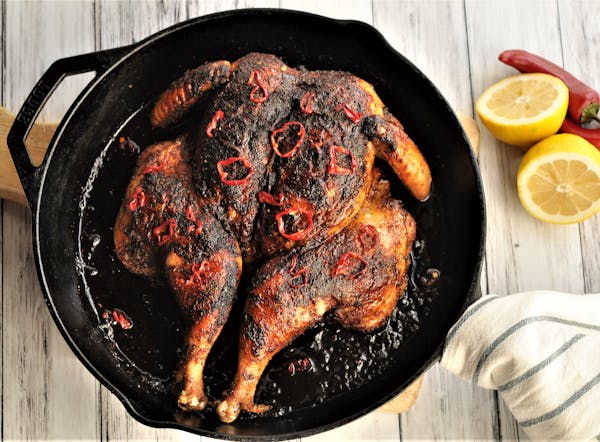A roasted chicken, juicy on the inside with a crispy, golden brown skin, has always been the centerpiece of Sunday dinner in my house. In the past, I've employed a traditional technique to roast it. Massage it with softened butter or olive oil, generously season with salt and pepper, plop it onto a roasting pan and into a hot oven until it's done.
Unfortunately, "done" hasn't always equaled a juicy chicken with a crispy, golden brown skin.
Recently though, I've been turning to a different technique that, while it sounds strange, has consistently produced some of the best roasted chicken my dinner table has ever seen.
Sometimes referred to as "Chicken Under a Brick" or "Pressed Chicken," the method is simple. All you need are a couple of bricks, a heavy, ovenproof skillet (or two skillets if you don't have bricks) and a whole chicken.
Let's start with the chicken. While I'm sure this would work with chicken pieces, I like to do this recipe with a whole chicken that's had the backbone removed. Butterflying a chicken, the term used for removing its backbone, is easy to do. Using a sharp pair of kitchen shears, just cut up both sides of the backbone (make sure you're not cutting up the breastbone). It just takes a minute, but if you're on friendly terms with your butcher, he will probably do it for you.
Seasoning of the chicken is up to you. Go simple, with salt and pepper. Or add some fresh herbs into the mix along with chopped garlic. Or use a little, or a lot, of spice, as I've done with this week's Pressed Spiced Chicken With Hot Honey Glaze.
A fragrant, Moroccan-inspired mixture of paprika, cumin, coriander and cinnamon is mixed with olive oil, salt and pepper and smeared all over the butterflied chicken.
The spiced chicken is placed, breast side down, into a hot skillet, topped with bricks or a weighted-down second skillet and cooked on top of the stove until the skin is browned. Weighing down the chicken ensures maximum contact between the meat and the skillet, which gives the chicken a beautifully crispy skin.
It's then transferred to the oven and cooked until it's almost done. The chicken's time in the oven is fairly short, because it got a head start on the stove. Less time roasting helps keep the chicken juicy. In the last part of the roasting process, a honey-lemon-red-chile glaze is brushed on the chicken.
Yes, the spices give this chicken a unique flavor, but the hot honey glaze is a game-changer. The subtle sweetness, combined with a bit of tartness from the lemon juice and heat from the chile, highlights both the flavors of the spices and the chicken itself. The combination is memorable.
Such a chicken deserves its place on a Sunday dinner table. Your family will be talking about it all week.
Meredith Deeds is a cookbook author and food writer from Edina. Reach her at meredith@meredithdeeds.com. Follow her on Twitter at
@meredithdeeds.
Judge in Trump case orders media not to report where potential jurors work
New attorney joins prosecution team against Alec Baldwin in fatal 'Rust' shooting
Booming cold drink sales mean more plastic waste. So Starbucks redesigned its cups

Allman Brothers Band co-founder and legendary guitarist Dickey Betts dies at 80

